Impact of Social Media on Business Performance: Marks and Spencer
VerifiedAdded on 2023/01/11
|16
|3557
|33
Report
AI Summary
This report investigates the impact of social media on business performance, focusing on a case study of Marks and Spencer within the retail industry. The study examines the role of social media as a commercial tool, exploring its effects on brand awareness, sales, and customer engagement. It presents a literature review discussing the benefits and challenges of social media marketing, supported by quantitative research using surveys. The methodology includes a simple random sampling of 55 respondents, with data analyzed using SPSS to determine the influence of social media on business outcomes. The results highlight the impact of social media on brand reputation, customer perception, and the challenges businesses face in managing online feedback. Statistical analyses, including Chi-square tests, are used to assess the relationship between gender, age, and attitudes toward social media marketing. The report concludes by summarizing the key findings and their implications for businesses leveraging social media.

CW3- Research Methods
Paraphrase This Document
Need a fresh take? Get an instant paraphrase of this document with our AI Paraphraser
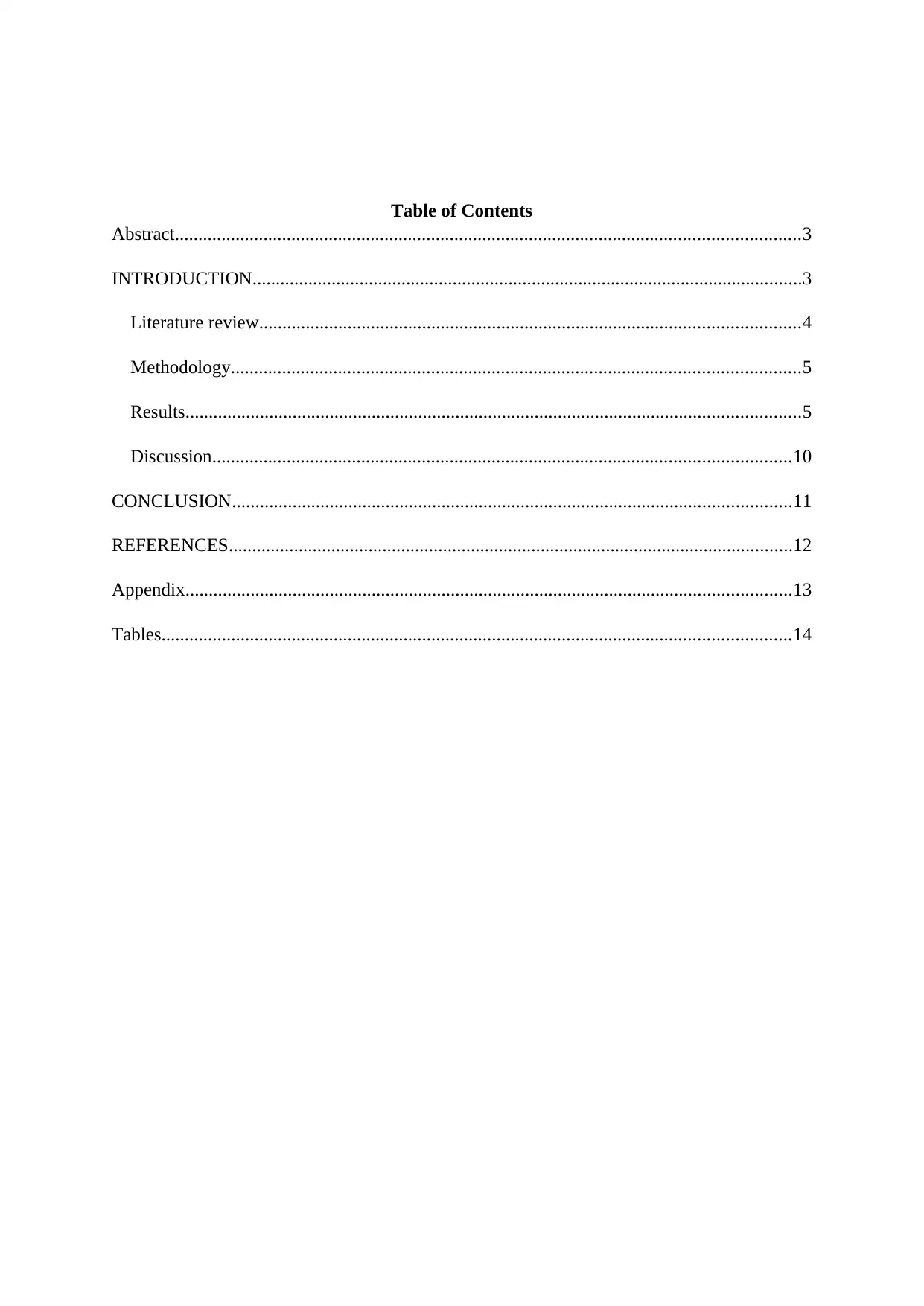
Table of Contents
Abstract......................................................................................................................................3
INTRODUCTION......................................................................................................................3
Literature review....................................................................................................................4
Methodology..........................................................................................................................5
Results....................................................................................................................................5
Discussion............................................................................................................................10
CONCLUSION........................................................................................................................11
REFERENCES.........................................................................................................................12
Appendix..................................................................................................................................13
Tables.......................................................................................................................................14
Abstract......................................................................................................................................3
INTRODUCTION......................................................................................................................3
Literature review....................................................................................................................4
Methodology..........................................................................................................................5
Results....................................................................................................................................5
Discussion............................................................................................................................10
CONCLUSION........................................................................................................................11
REFERENCES.........................................................................................................................12
Appendix..................................................................................................................................13
Tables.......................................................................................................................................14
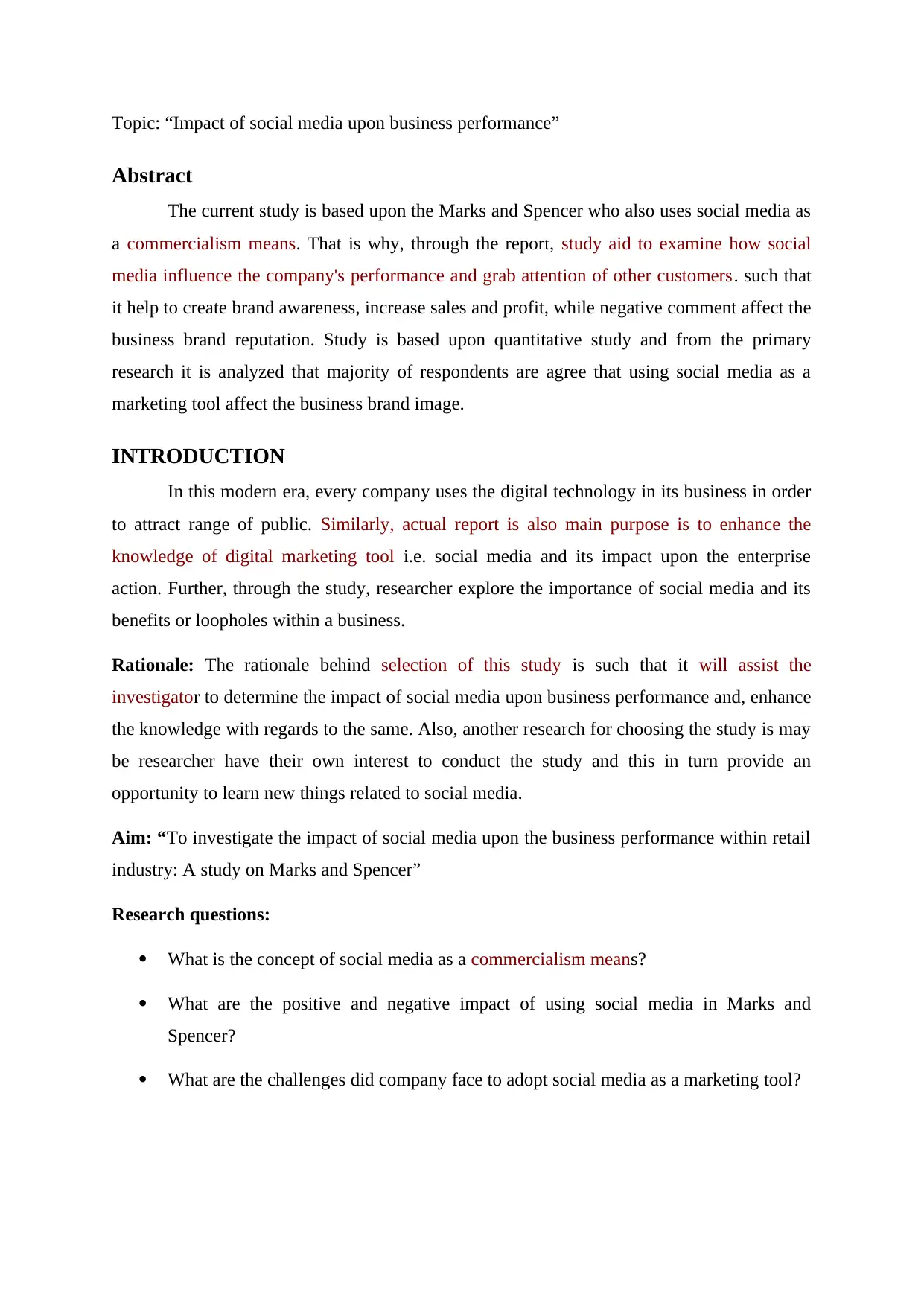
Topic: “Impact of social media upon business performance”
Abstract
The current study is based upon the Marks and Spencer who also uses social media as
a commercialism means. That is why, through the report, study aid to examine how social
media influence the company's performance and grab attention of other customers. such that
it help to create brand awareness, increase sales and profit, while negative comment affect the
business brand reputation. Study is based upon quantitative study and from the primary
research it is analyzed that majority of respondents are agree that using social media as a
marketing tool affect the business brand image.
INTRODUCTION
In this modern era, every company uses the digital technology in its business in order
to attract range of public. Similarly, actual report is also main purpose is to enhance the
knowledge of digital marketing tool i.e. social media and its impact upon the enterprise
action. Further, through the study, researcher explore the importance of social media and its
benefits or loopholes within a business.
Rationale: The rationale behind selection of this study is such that it will assist the
investigator to determine the impact of social media upon business performance and, enhance
the knowledge with regards to the same. Also, another research for choosing the study is may
be researcher have their own interest to conduct the study and this in turn provide an
opportunity to learn new things related to social media.
Aim: “To investigate the impact of social media upon the business performance within retail
industry: A study on Marks and Spencer”
Research questions:
What is the concept of social media as a commercialism means?
What are the positive and negative impact of using social media in Marks and
Spencer?
What are the challenges did company face to adopt social media as a marketing tool?
Abstract
The current study is based upon the Marks and Spencer who also uses social media as
a commercialism means. That is why, through the report, study aid to examine how social
media influence the company's performance and grab attention of other customers. such that
it help to create brand awareness, increase sales and profit, while negative comment affect the
business brand reputation. Study is based upon quantitative study and from the primary
research it is analyzed that majority of respondents are agree that using social media as a
marketing tool affect the business brand image.
INTRODUCTION
In this modern era, every company uses the digital technology in its business in order
to attract range of public. Similarly, actual report is also main purpose is to enhance the
knowledge of digital marketing tool i.e. social media and its impact upon the enterprise
action. Further, through the study, researcher explore the importance of social media and its
benefits or loopholes within a business.
Rationale: The rationale behind selection of this study is such that it will assist the
investigator to determine the impact of social media upon business performance and, enhance
the knowledge with regards to the same. Also, another research for choosing the study is may
be researcher have their own interest to conduct the study and this in turn provide an
opportunity to learn new things related to social media.
Aim: “To investigate the impact of social media upon the business performance within retail
industry: A study on Marks and Spencer”
Research questions:
What is the concept of social media as a commercialism means?
What are the positive and negative impact of using social media in Marks and
Spencer?
What are the challenges did company face to adopt social media as a marketing tool?
⊘ This is a preview!⊘
Do you want full access?
Subscribe today to unlock all pages.

Trusted by 1+ million students worldwide
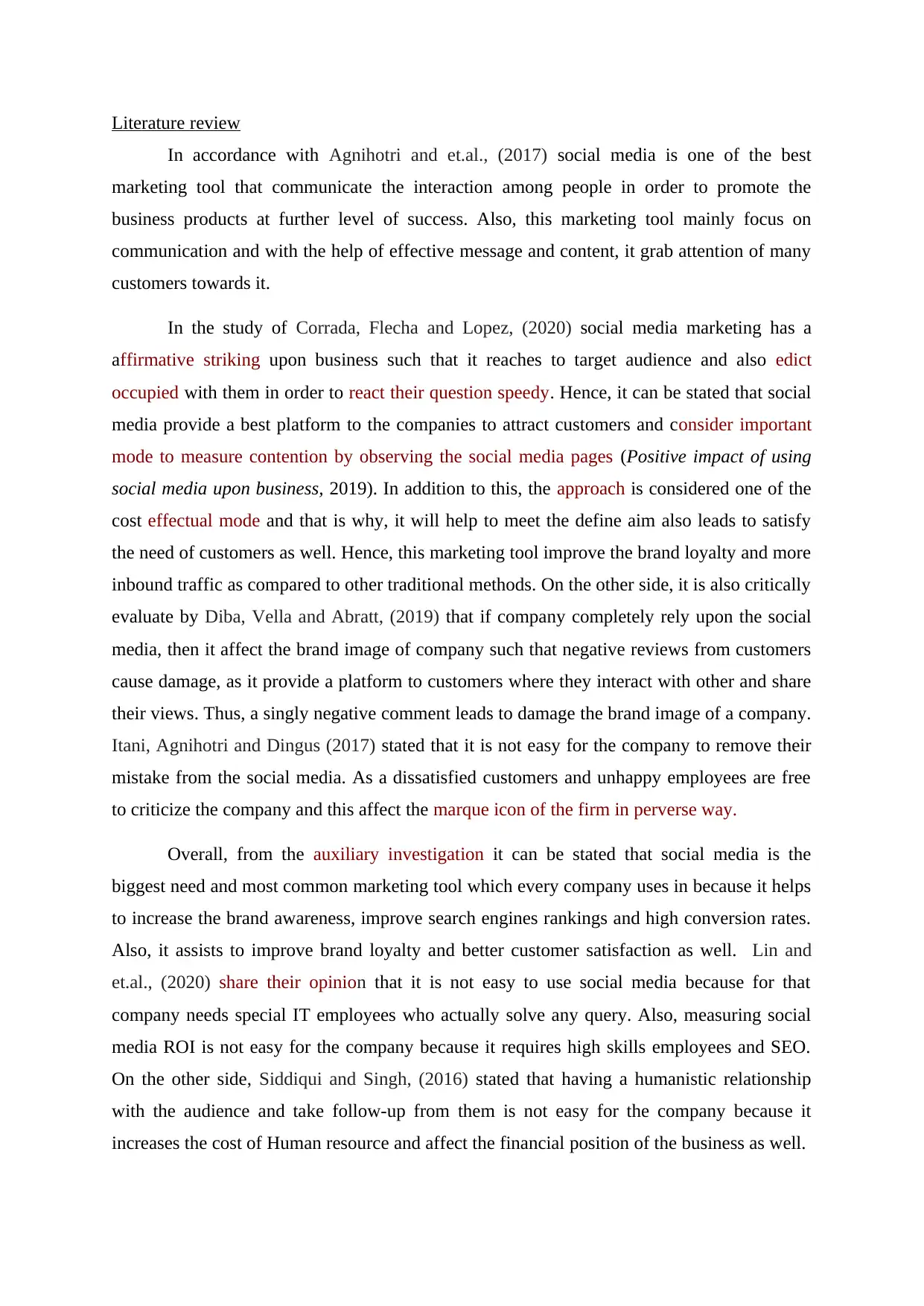
Literature review
In accordance with Agnihotri and et.al., (2017) social media is one of the best
marketing tool that communicate the interaction among people in order to promote the
business products at further level of success. Also, this marketing tool mainly focus on
communication and with the help of effective message and content, it grab attention of many
customers towards it.
In the study of Corrada, Flecha and Lopez, (2020) social media marketing has a
affirmative striking upon business such that it reaches to target audience and also edict
occupied with them in order to react their question speedy. Hence, it can be stated that social
media provide a best platform to the companies to attract customers and consider important
mode to measure contention by observing the social media pages (Positive impact of using
social media upon business, 2019). In addition to this, the approach is considered one of the
cost effectual mode and that is why, it will help to meet the define aim also leads to satisfy
the need of customers as well. Hence, this marketing tool improve the brand loyalty and more
inbound traffic as compared to other traditional methods. On the other side, it is also critically
evaluate by Diba, Vella and Abratt, (2019) that if company completely rely upon the social
media, then it affect the brand image of company such that negative reviews from customers
cause damage, as it provide a platform to customers where they interact with other and share
their views. Thus, a singly negative comment leads to damage the brand image of a company.
Itani, Agnihotri and Dingus (2017) stated that it is not easy for the company to remove their
mistake from the social media. As a dissatisfied customers and unhappy employees are free
to criticize the company and this affect the marque icon of the firm in perverse way.
Overall, from the auxiliary investigation it can be stated that social media is the
biggest need and most common marketing tool which every company uses in because it helps
to increase the brand awareness, improve search engines rankings and high conversion rates.
Also, it assists to improve brand loyalty and better customer satisfaction as well. Lin and
et.al., (2020) share their opinion that it is not easy to use social media because for that
company needs special IT employees who actually solve any query. Also, measuring social
media ROI is not easy for the company because it requires high skills employees and SEO.
On the other side, Siddiqui and Singh, (2016) stated that having a humanistic relationship
with the audience and take follow-up from them is not easy for the company because it
increases the cost of Human resource and affect the financial position of the business as well.
In accordance with Agnihotri and et.al., (2017) social media is one of the best
marketing tool that communicate the interaction among people in order to promote the
business products at further level of success. Also, this marketing tool mainly focus on
communication and with the help of effective message and content, it grab attention of many
customers towards it.
In the study of Corrada, Flecha and Lopez, (2020) social media marketing has a
affirmative striking upon business such that it reaches to target audience and also edict
occupied with them in order to react their question speedy. Hence, it can be stated that social
media provide a best platform to the companies to attract customers and consider important
mode to measure contention by observing the social media pages (Positive impact of using
social media upon business, 2019). In addition to this, the approach is considered one of the
cost effectual mode and that is why, it will help to meet the define aim also leads to satisfy
the need of customers as well. Hence, this marketing tool improve the brand loyalty and more
inbound traffic as compared to other traditional methods. On the other side, it is also critically
evaluate by Diba, Vella and Abratt, (2019) that if company completely rely upon the social
media, then it affect the brand image of company such that negative reviews from customers
cause damage, as it provide a platform to customers where they interact with other and share
their views. Thus, a singly negative comment leads to damage the brand image of a company.
Itani, Agnihotri and Dingus (2017) stated that it is not easy for the company to remove their
mistake from the social media. As a dissatisfied customers and unhappy employees are free
to criticize the company and this affect the marque icon of the firm in perverse way.
Overall, from the auxiliary investigation it can be stated that social media is the
biggest need and most common marketing tool which every company uses in because it helps
to increase the brand awareness, improve search engines rankings and high conversion rates.
Also, it assists to improve brand loyalty and better customer satisfaction as well. Lin and
et.al., (2020) share their opinion that it is not easy to use social media because for that
company needs special IT employees who actually solve any query. Also, measuring social
media ROI is not easy for the company because it requires high skills employees and SEO.
On the other side, Siddiqui and Singh, (2016) stated that having a humanistic relationship
with the audience and take follow-up from them is not easy for the company because it
increases the cost of Human resource and affect the financial position of the business as well.
Paraphrase This Document
Need a fresh take? Get an instant paraphrase of this document with our AI Paraphraser
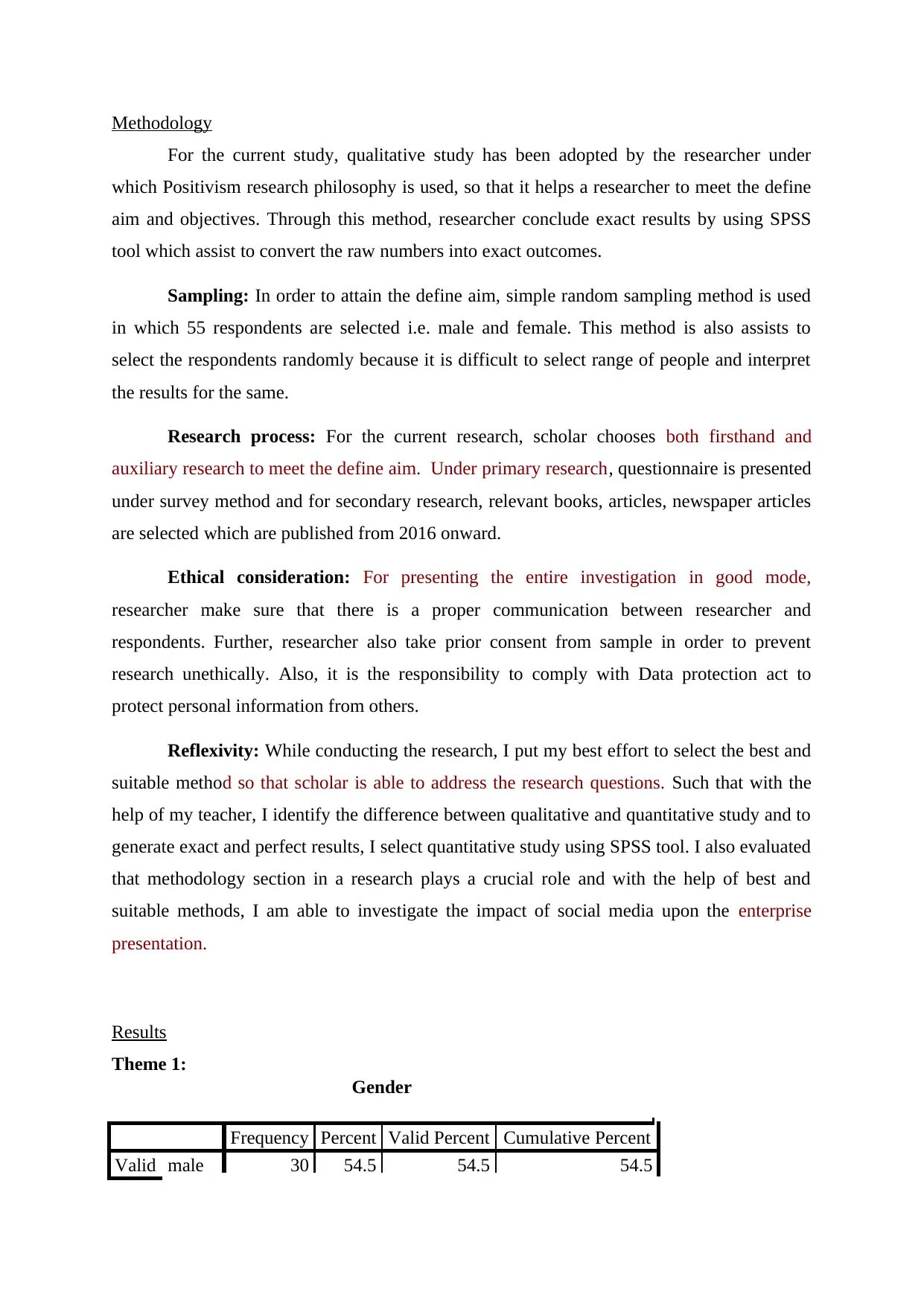
Methodology
For the current study, qualitative study has been adopted by the researcher under
which Positivism research philosophy is used, so that it helps a researcher to meet the define
aim and objectives. Through this method, researcher conclude exact results by using SPSS
tool which assist to convert the raw numbers into exact outcomes.
Sampling: In order to attain the define aim, simple random sampling method is used
in which 55 respondents are selected i.e. male and female. This method is also assists to
select the respondents randomly because it is difficult to select range of people and interpret
the results for the same.
Research process: For the current research, scholar chooses both firsthand and
auxiliary research to meet the define aim. Under primary research, questionnaire is presented
under survey method and for secondary research, relevant books, articles, newspaper articles
are selected which are published from 2016 onward.
Ethical consideration: For presenting the entire investigation in good mode,
researcher make sure that there is a proper communication between researcher and
respondents. Further, researcher also take prior consent from sample in order to prevent
research unethically. Also, it is the responsibility to comply with Data protection act to
protect personal information from others.
Reflexivity: While conducting the research, I put my best effort to select the best and
suitable method so that scholar is able to address the research questions. Such that with the
help of my teacher, I identify the difference between qualitative and quantitative study and to
generate exact and perfect results, I select quantitative study using SPSS tool. I also evaluated
that methodology section in a research plays a crucial role and with the help of best and
suitable methods, I am able to investigate the impact of social media upon the enterprise
presentation.
Results
Theme 1:
Gender
Frequency Percent Valid Percent Cumulative Percent
Valid male 30 54.5 54.5 54.5
For the current study, qualitative study has been adopted by the researcher under
which Positivism research philosophy is used, so that it helps a researcher to meet the define
aim and objectives. Through this method, researcher conclude exact results by using SPSS
tool which assist to convert the raw numbers into exact outcomes.
Sampling: In order to attain the define aim, simple random sampling method is used
in which 55 respondents are selected i.e. male and female. This method is also assists to
select the respondents randomly because it is difficult to select range of people and interpret
the results for the same.
Research process: For the current research, scholar chooses both firsthand and
auxiliary research to meet the define aim. Under primary research, questionnaire is presented
under survey method and for secondary research, relevant books, articles, newspaper articles
are selected which are published from 2016 onward.
Ethical consideration: For presenting the entire investigation in good mode,
researcher make sure that there is a proper communication between researcher and
respondents. Further, researcher also take prior consent from sample in order to prevent
research unethically. Also, it is the responsibility to comply with Data protection act to
protect personal information from others.
Reflexivity: While conducting the research, I put my best effort to select the best and
suitable method so that scholar is able to address the research questions. Such that with the
help of my teacher, I identify the difference between qualitative and quantitative study and to
generate exact and perfect results, I select quantitative study using SPSS tool. I also evaluated
that methodology section in a research plays a crucial role and with the help of best and
suitable methods, I am able to investigate the impact of social media upon the enterprise
presentation.
Results
Theme 1:
Gender
Frequency Percent Valid Percent Cumulative Percent
Valid male 30 54.5 54.5 54.5
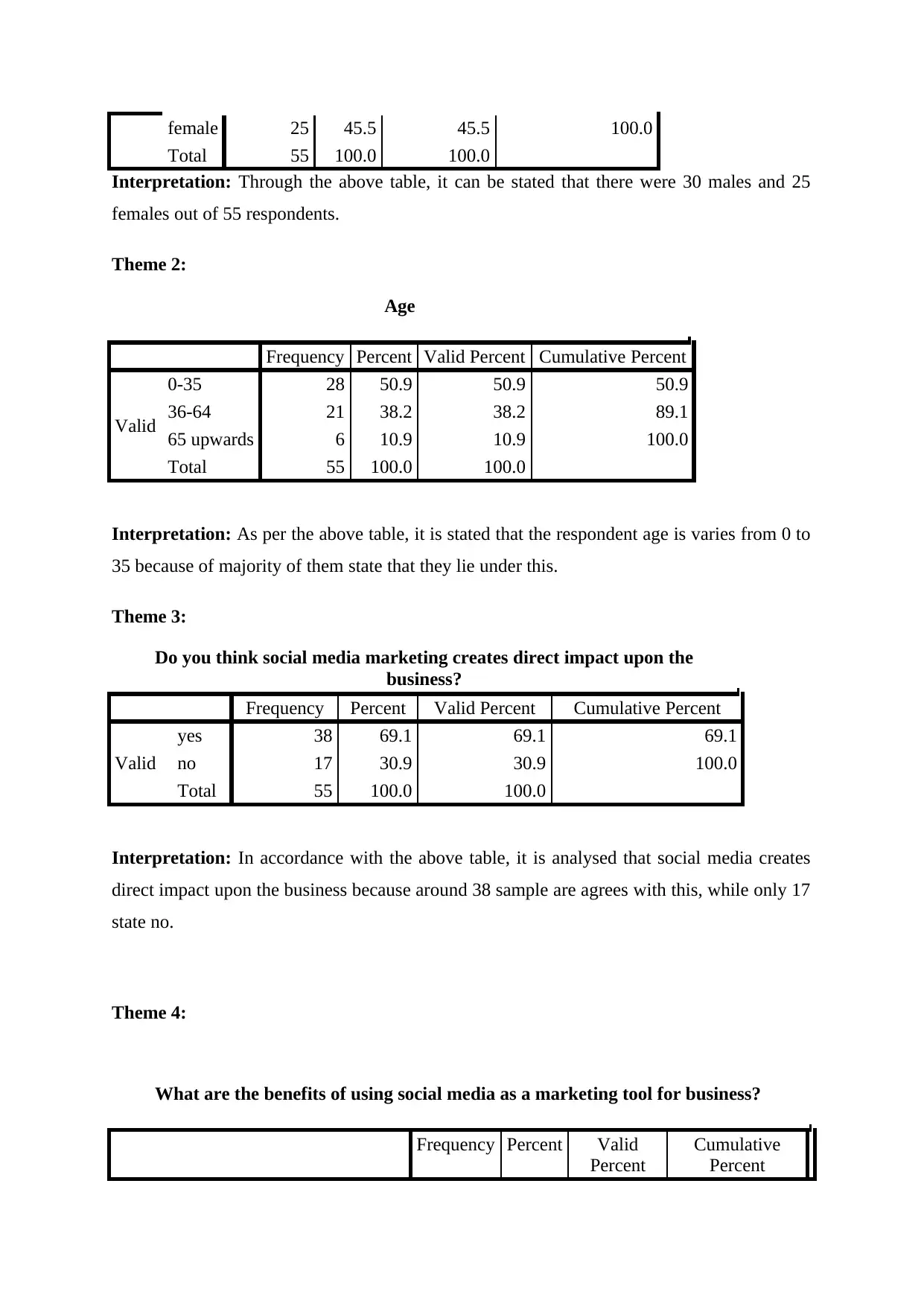
female 25 45.5 45.5 100.0
Total 55 100.0 100.0
Interpretation: Through the above table, it can be stated that there were 30 males and 25
females out of 55 respondents.
Theme 2:
Age
Frequency Percent Valid Percent Cumulative Percent
Valid
0-35 28 50.9 50.9 50.9
36-64 21 38.2 38.2 89.1
65 upwards 6 10.9 10.9 100.0
Total 55 100.0 100.0
Interpretation: As per the above table, it is stated that the respondent age is varies from 0 to
35 because of majority of them state that they lie under this.
Theme 3:
Do you think social media marketing creates direct impact upon the
business?
Frequency Percent Valid Percent Cumulative Percent
Valid
yes 38 69.1 69.1 69.1
no 17 30.9 30.9 100.0
Total 55 100.0 100.0
Interpretation: In accordance with the above table, it is analysed that social media creates
direct impact upon the business because around 38 sample are agrees with this, while only 17
state no.
Theme 4:
What are the benefits of using social media as a marketing tool for business?
Frequency Percent Valid
Percent
Cumulative
Percent
Total 55 100.0 100.0
Interpretation: Through the above table, it can be stated that there were 30 males and 25
females out of 55 respondents.
Theme 2:
Age
Frequency Percent Valid Percent Cumulative Percent
Valid
0-35 28 50.9 50.9 50.9
36-64 21 38.2 38.2 89.1
65 upwards 6 10.9 10.9 100.0
Total 55 100.0 100.0
Interpretation: As per the above table, it is stated that the respondent age is varies from 0 to
35 because of majority of them state that they lie under this.
Theme 3:
Do you think social media marketing creates direct impact upon the
business?
Frequency Percent Valid Percent Cumulative Percent
Valid
yes 38 69.1 69.1 69.1
no 17 30.9 30.9 100.0
Total 55 100.0 100.0
Interpretation: In accordance with the above table, it is analysed that social media creates
direct impact upon the business because around 38 sample are agrees with this, while only 17
state no.
Theme 4:
What are the benefits of using social media as a marketing tool for business?
Frequency Percent Valid
Percent
Cumulative
Percent
⊘ This is a preview!⊘
Do you want full access?
Subscribe today to unlock all pages.

Trusted by 1+ million students worldwide
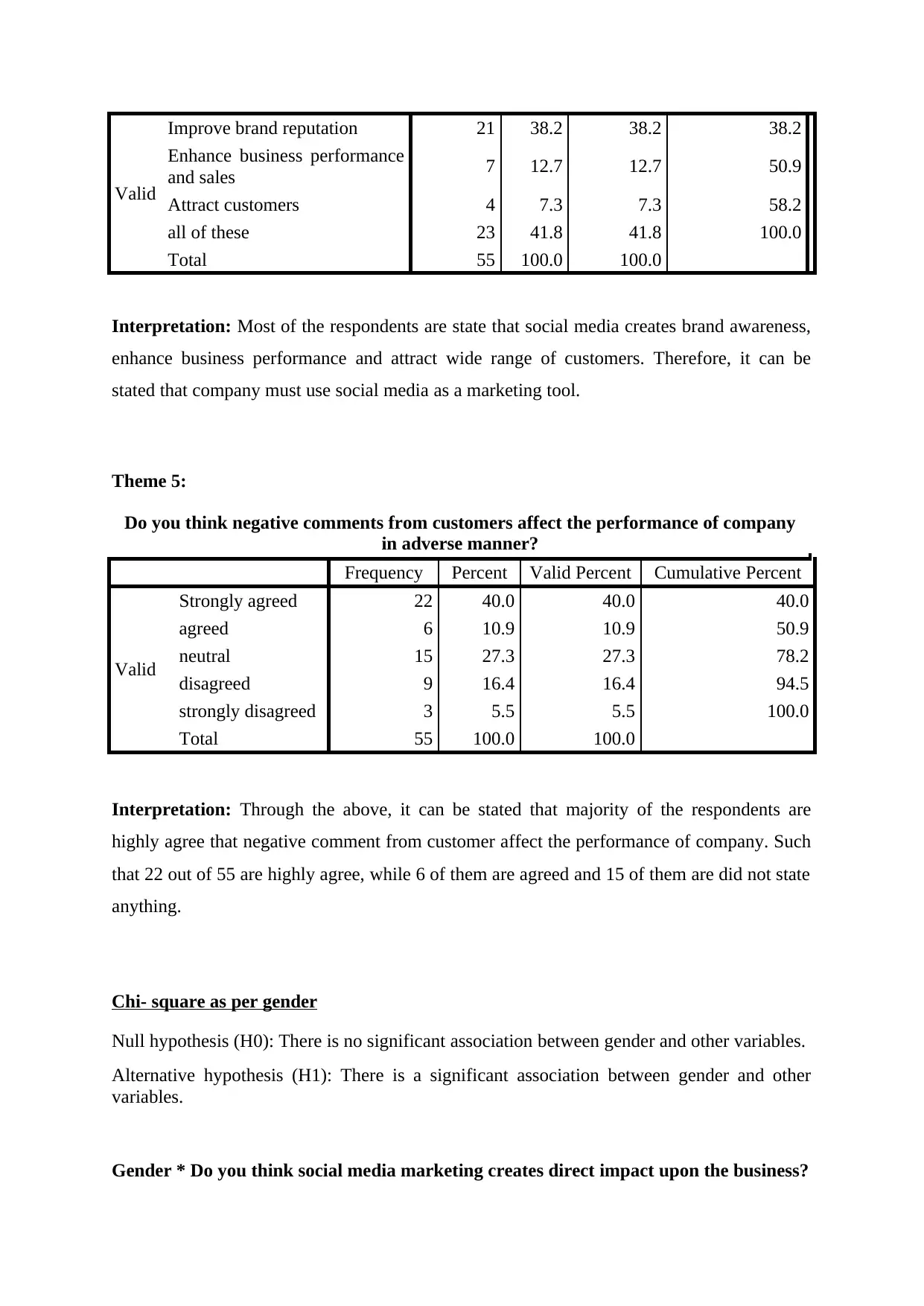
Valid
Improve brand reputation 21 38.2 38.2 38.2
Enhance business performance
and sales 7 12.7 12.7 50.9
Attract customers 4 7.3 7.3 58.2
all of these 23 41.8 41.8 100.0
Total 55 100.0 100.0
Interpretation: Most of the respondents are state that social media creates brand awareness,
enhance business performance and attract wide range of customers. Therefore, it can be
stated that company must use social media as a marketing tool.
Theme 5:
Do you think negative comments from customers affect the performance of company
in adverse manner?
Frequency Percent Valid Percent Cumulative Percent
Valid
Strongly agreed 22 40.0 40.0 40.0
agreed 6 10.9 10.9 50.9
neutral 15 27.3 27.3 78.2
disagreed 9 16.4 16.4 94.5
strongly disagreed 3 5.5 5.5 100.0
Total 55 100.0 100.0
Interpretation: Through the above, it can be stated that majority of the respondents are
highly agree that negative comment from customer affect the performance of company. Such
that 22 out of 55 are highly agree, while 6 of them are agreed and 15 of them are did not state
anything.
Chi- square as per gender
Null hypothesis (H0): There is no significant association between gender and other variables.
Alternative hypothesis (H1): There is a significant association between gender and other
variables.
Gender * Do you think social media marketing creates direct impact upon the business?
Improve brand reputation 21 38.2 38.2 38.2
Enhance business performance
and sales 7 12.7 12.7 50.9
Attract customers 4 7.3 7.3 58.2
all of these 23 41.8 41.8 100.0
Total 55 100.0 100.0
Interpretation: Most of the respondents are state that social media creates brand awareness,
enhance business performance and attract wide range of customers. Therefore, it can be
stated that company must use social media as a marketing tool.
Theme 5:
Do you think negative comments from customers affect the performance of company
in adverse manner?
Frequency Percent Valid Percent Cumulative Percent
Valid
Strongly agreed 22 40.0 40.0 40.0
agreed 6 10.9 10.9 50.9
neutral 15 27.3 27.3 78.2
disagreed 9 16.4 16.4 94.5
strongly disagreed 3 5.5 5.5 100.0
Total 55 100.0 100.0
Interpretation: Through the above, it can be stated that majority of the respondents are
highly agree that negative comment from customer affect the performance of company. Such
that 22 out of 55 are highly agree, while 6 of them are agreed and 15 of them are did not state
anything.
Chi- square as per gender
Null hypothesis (H0): There is no significant association between gender and other variables.
Alternative hypothesis (H1): There is a significant association between gender and other
variables.
Gender * Do you think social media marketing creates direct impact upon the business?
Paraphrase This Document
Need a fresh take? Get an instant paraphrase of this document with our AI Paraphraser
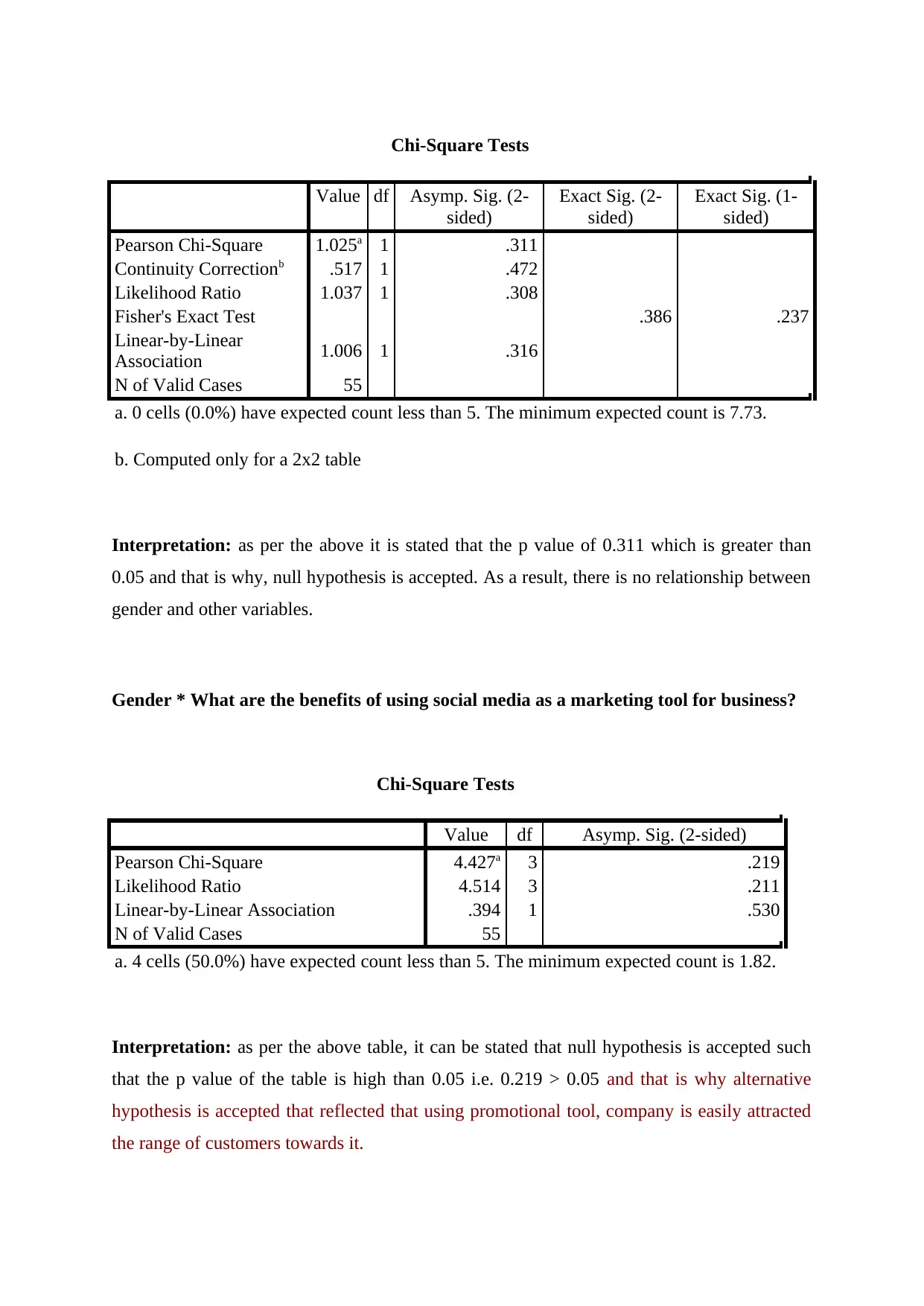
Chi-Square Tests
Value df Asymp. Sig. (2-
sided)
Exact Sig. (2-
sided)
Exact Sig. (1-
sided)
Pearson Chi-Square 1.025a 1 .311
Continuity Correctionb .517 1 .472
Likelihood Ratio 1.037 1 .308
Fisher's Exact Test .386 .237
Linear-by-Linear
Association 1.006 1 .316
N of Valid Cases 55
a. 0 cells (0.0%) have expected count less than 5. The minimum expected count is 7.73.
b. Computed only for a 2x2 table
Interpretation: as per the above it is stated that the p value of 0.311 which is greater than
0.05 and that is why, null hypothesis is accepted. As a result, there is no relationship between
gender and other variables.
Gender * What are the benefits of using social media as a marketing tool for business?
Chi-Square Tests
Value df Asymp. Sig. (2-sided)
Pearson Chi-Square 4.427a 3 .219
Likelihood Ratio 4.514 3 .211
Linear-by-Linear Association .394 1 .530
N of Valid Cases 55
a. 4 cells (50.0%) have expected count less than 5. The minimum expected count is 1.82.
Interpretation: as per the above table, it can be stated that null hypothesis is accepted such
that the p value of the table is high than 0.05 i.e. 0.219 > 0.05 and that is why alternative
hypothesis is accepted that reflected that using promotional tool, company is easily attracted
the range of customers towards it.
Value df Asymp. Sig. (2-
sided)
Exact Sig. (2-
sided)
Exact Sig. (1-
sided)
Pearson Chi-Square 1.025a 1 .311
Continuity Correctionb .517 1 .472
Likelihood Ratio 1.037 1 .308
Fisher's Exact Test .386 .237
Linear-by-Linear
Association 1.006 1 .316
N of Valid Cases 55
a. 0 cells (0.0%) have expected count less than 5. The minimum expected count is 7.73.
b. Computed only for a 2x2 table
Interpretation: as per the above it is stated that the p value of 0.311 which is greater than
0.05 and that is why, null hypothesis is accepted. As a result, there is no relationship between
gender and other variables.
Gender * What are the benefits of using social media as a marketing tool for business?
Chi-Square Tests
Value df Asymp. Sig. (2-sided)
Pearson Chi-Square 4.427a 3 .219
Likelihood Ratio 4.514 3 .211
Linear-by-Linear Association .394 1 .530
N of Valid Cases 55
a. 4 cells (50.0%) have expected count less than 5. The minimum expected count is 1.82.
Interpretation: as per the above table, it can be stated that null hypothesis is accepted such
that the p value of the table is high than 0.05 i.e. 0.219 > 0.05 and that is why alternative
hypothesis is accepted that reflected that using promotional tool, company is easily attracted
the range of customers towards it.
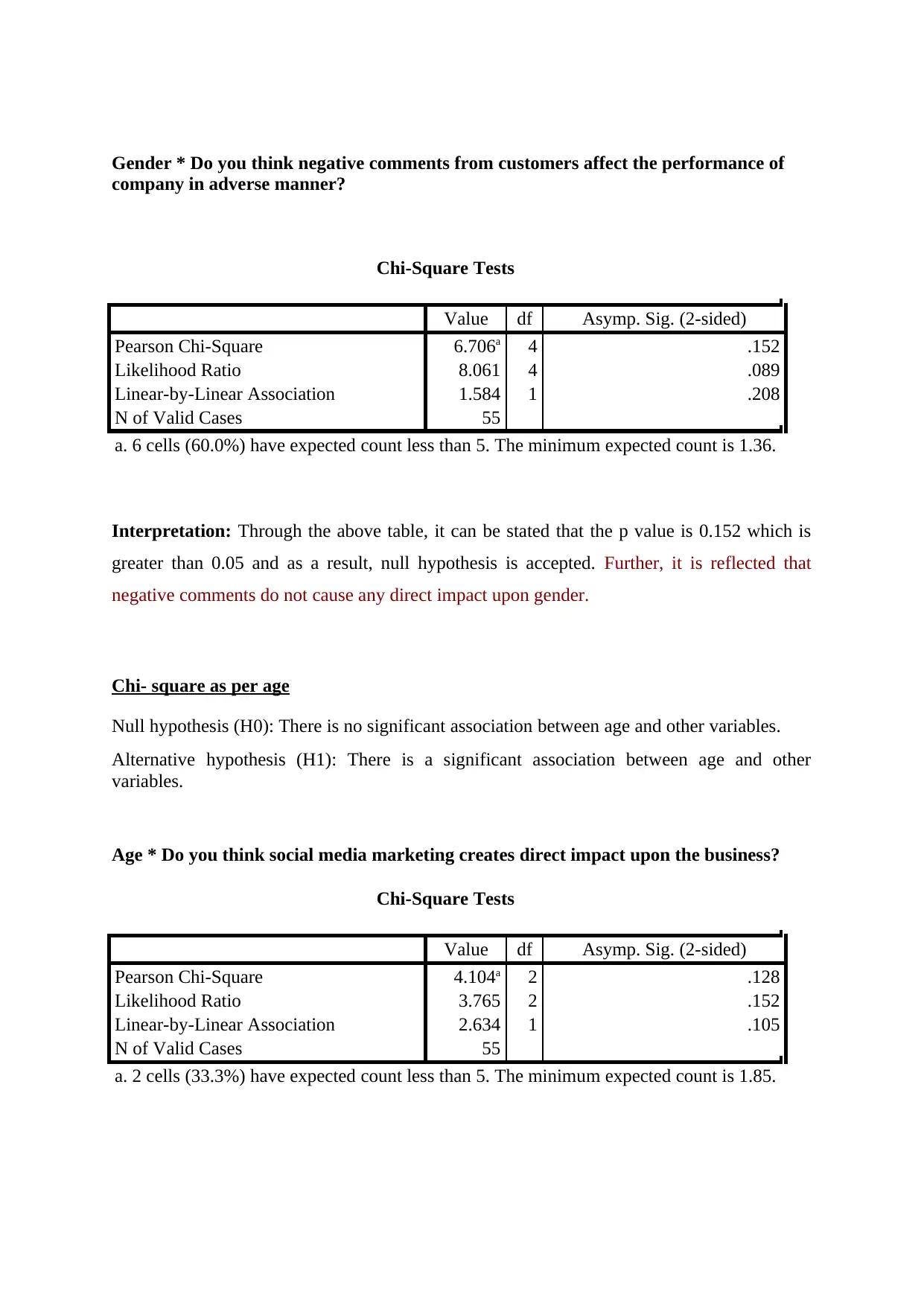
Gender * Do you think negative comments from customers affect the performance of
company in adverse manner?
Chi-Square Tests
Value df Asymp. Sig. (2-sided)
Pearson Chi-Square 6.706a 4 .152
Likelihood Ratio 8.061 4 .089
Linear-by-Linear Association 1.584 1 .208
N of Valid Cases 55
a. 6 cells (60.0%) have expected count less than 5. The minimum expected count is 1.36.
Interpretation: Through the above table, it can be stated that the p value is 0.152 which is
greater than 0.05 and as a result, null hypothesis is accepted. Further, it is reflected that
negative comments do not cause any direct impact upon gender.
Chi- square as per age
Null hypothesis (H0): There is no significant association between age and other variables.
Alternative hypothesis (H1): There is a significant association between age and other
variables.
Age * Do you think social media marketing creates direct impact upon the business?
Chi-Square Tests
Value df Asymp. Sig. (2-sided)
Pearson Chi-Square 4.104a 2 .128
Likelihood Ratio 3.765 2 .152
Linear-by-Linear Association 2.634 1 .105
N of Valid Cases 55
a. 2 cells (33.3%) have expected count less than 5. The minimum expected count is 1.85.
company in adverse manner?
Chi-Square Tests
Value df Asymp. Sig. (2-sided)
Pearson Chi-Square 6.706a 4 .152
Likelihood Ratio 8.061 4 .089
Linear-by-Linear Association 1.584 1 .208
N of Valid Cases 55
a. 6 cells (60.0%) have expected count less than 5. The minimum expected count is 1.36.
Interpretation: Through the above table, it can be stated that the p value is 0.152 which is
greater than 0.05 and as a result, null hypothesis is accepted. Further, it is reflected that
negative comments do not cause any direct impact upon gender.
Chi- square as per age
Null hypothesis (H0): There is no significant association between age and other variables.
Alternative hypothesis (H1): There is a significant association between age and other
variables.
Age * Do you think social media marketing creates direct impact upon the business?
Chi-Square Tests
Value df Asymp. Sig. (2-sided)
Pearson Chi-Square 4.104a 2 .128
Likelihood Ratio 3.765 2 .152
Linear-by-Linear Association 2.634 1 .105
N of Valid Cases 55
a. 2 cells (33.3%) have expected count less than 5. The minimum expected count is 1.85.
⊘ This is a preview!⊘
Do you want full access?
Subscribe today to unlock all pages.

Trusted by 1+ million students worldwide
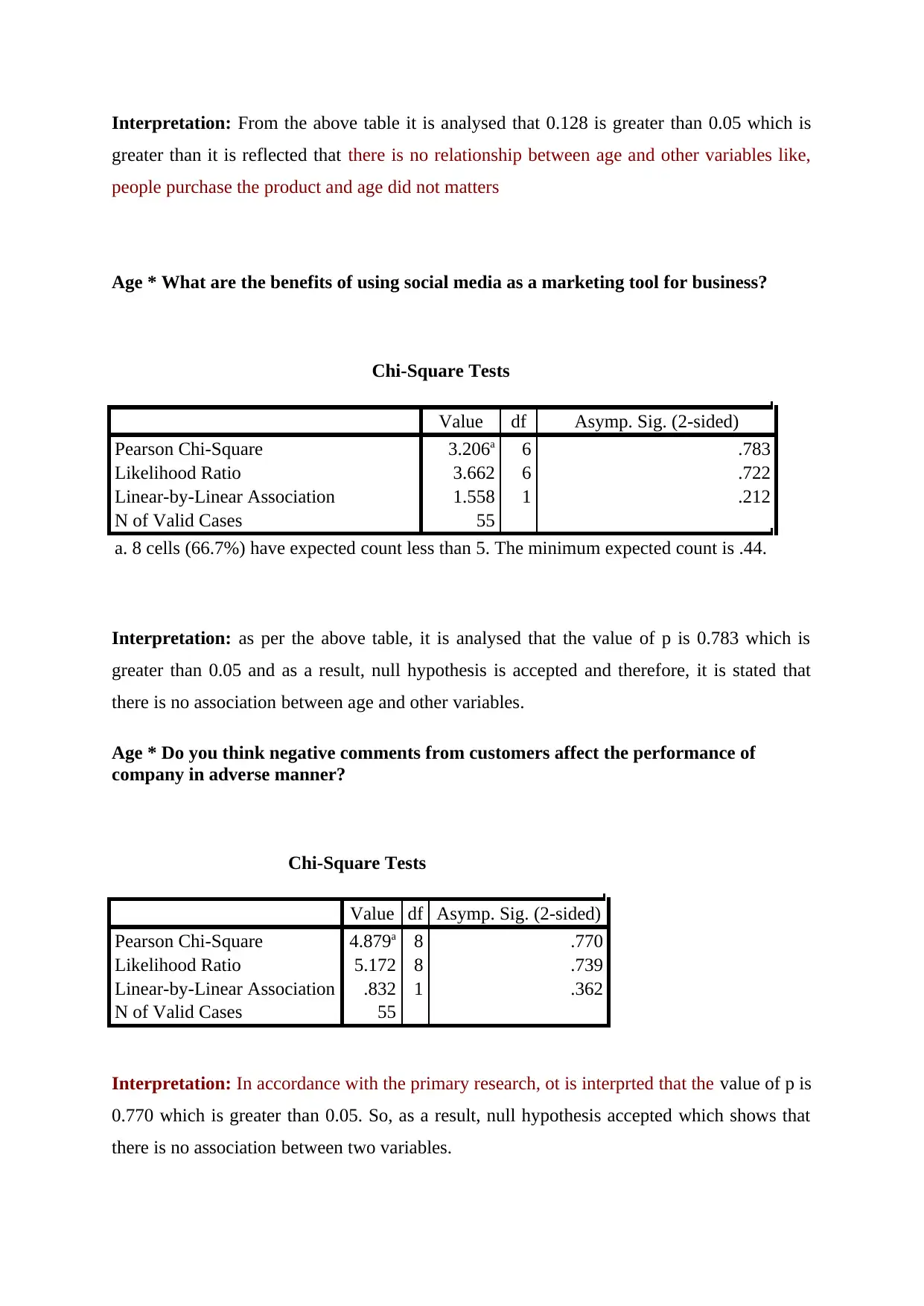
Interpretation: From the above table it is analysed that 0.128 is greater than 0.05 which is
greater than it is reflected that there is no relationship between age and other variables like,
people purchase the product and age did not matters
Age * What are the benefits of using social media as a marketing tool for business?
Chi-Square Tests
Value df Asymp. Sig. (2-sided)
Pearson Chi-Square 3.206a 6 .783
Likelihood Ratio 3.662 6 .722
Linear-by-Linear Association 1.558 1 .212
N of Valid Cases 55
a. 8 cells (66.7%) have expected count less than 5. The minimum expected count is .44.
Interpretation: as per the above table, it is analysed that the value of p is 0.783 which is
greater than 0.05 and as a result, null hypothesis is accepted and therefore, it is stated that
there is no association between age and other variables.
Age * Do you think negative comments from customers affect the performance of
company in adverse manner?
Chi-Square Tests
Value df Asymp. Sig. (2-sided)
Pearson Chi-Square 4.879a 8 .770
Likelihood Ratio 5.172 8 .739
Linear-by-Linear Association .832 1 .362
N of Valid Cases 55
Interpretation: In accordance with the primary research, ot is interprted that the value of p is
0.770 which is greater than 0.05. So, as a result, null hypothesis accepted which shows that
there is no association between two variables.
greater than it is reflected that there is no relationship between age and other variables like,
people purchase the product and age did not matters
Age * What are the benefits of using social media as a marketing tool for business?
Chi-Square Tests
Value df Asymp. Sig. (2-sided)
Pearson Chi-Square 3.206a 6 .783
Likelihood Ratio 3.662 6 .722
Linear-by-Linear Association 1.558 1 .212
N of Valid Cases 55
a. 8 cells (66.7%) have expected count less than 5. The minimum expected count is .44.
Interpretation: as per the above table, it is analysed that the value of p is 0.783 which is
greater than 0.05 and as a result, null hypothesis is accepted and therefore, it is stated that
there is no association between age and other variables.
Age * Do you think negative comments from customers affect the performance of
company in adverse manner?
Chi-Square Tests
Value df Asymp. Sig. (2-sided)
Pearson Chi-Square 4.879a 8 .770
Likelihood Ratio 5.172 8 .739
Linear-by-Linear Association .832 1 .362
N of Valid Cases 55
Interpretation: In accordance with the primary research, ot is interprted that the value of p is
0.770 which is greater than 0.05. So, as a result, null hypothesis accepted which shows that
there is no association between two variables.
Paraphrase This Document
Need a fresh take? Get an instant paraphrase of this document with our AI Paraphraser
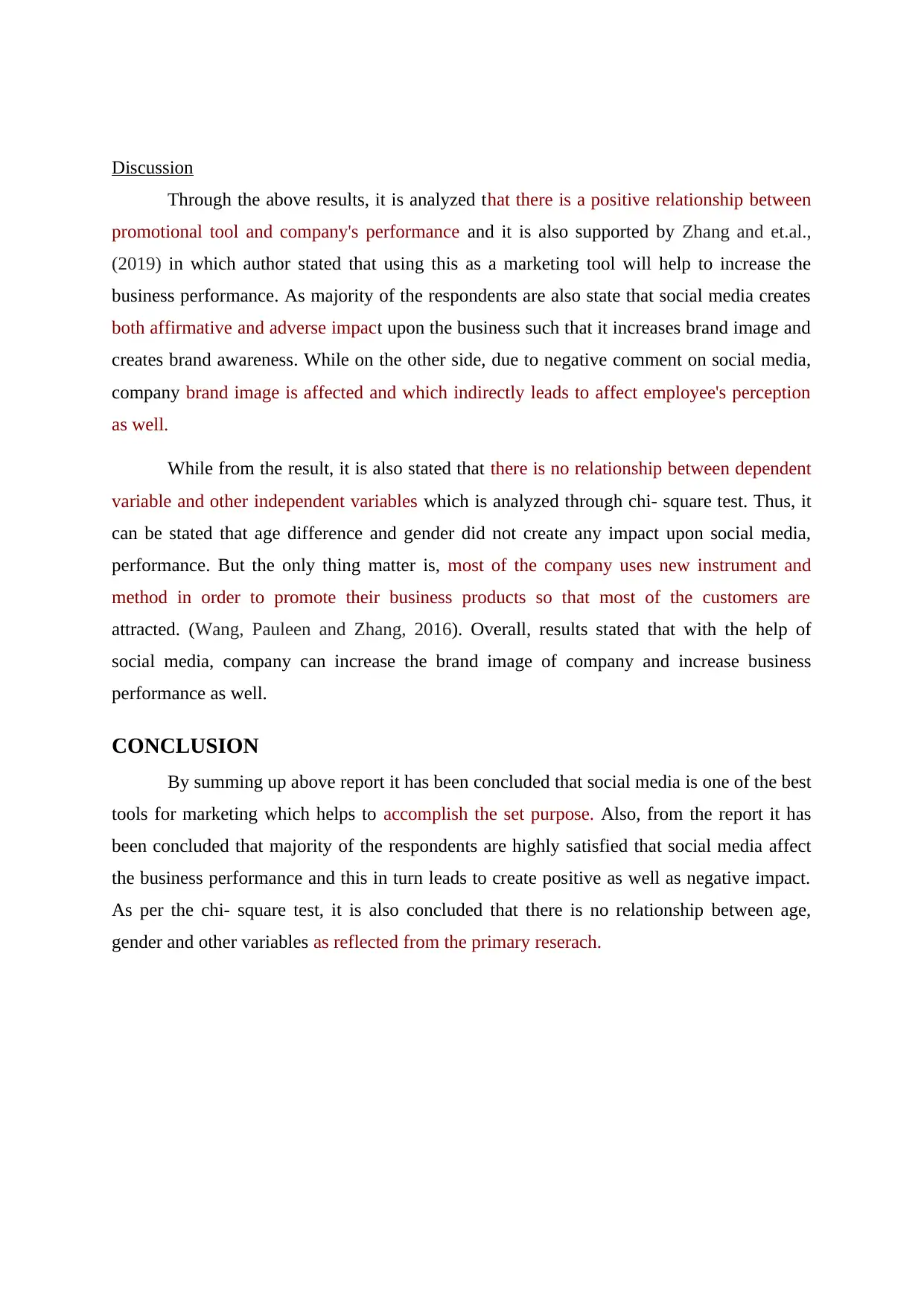
Discussion
Through the above results, it is analyzed that there is a positive relationship between
promotional tool and company's performance and it is also supported by Zhang and et.al.,
(2019) in which author stated that using this as a marketing tool will help to increase the
business performance. As majority of the respondents are also state that social media creates
both affirmative and adverse impact upon the business such that it increases brand image and
creates brand awareness. While on the other side, due to negative comment on social media,
company brand image is affected and which indirectly leads to affect employee's perception
as well.
While from the result, it is also stated that there is no relationship between dependent
variable and other independent variables which is analyzed through chi- square test. Thus, it
can be stated that age difference and gender did not create any impact upon social media,
performance. But the only thing matter is, most of the company uses new instrument and
method in order to promote their business products so that most of the customers are
attracted. (Wang, Pauleen and Zhang, 2016). Overall, results stated that with the help of
social media, company can increase the brand image of company and increase business
performance as well.
CONCLUSION
By summing up above report it has been concluded that social media is one of the best
tools for marketing which helps to accomplish the set purpose. Also, from the report it has
been concluded that majority of the respondents are highly satisfied that social media affect
the business performance and this in turn leads to create positive as well as negative impact.
As per the chi- square test, it is also concluded that there is no relationship between age,
gender and other variables as reflected from the primary reserach.
Through the above results, it is analyzed that there is a positive relationship between
promotional tool and company's performance and it is also supported by Zhang and et.al.,
(2019) in which author stated that using this as a marketing tool will help to increase the
business performance. As majority of the respondents are also state that social media creates
both affirmative and adverse impact upon the business such that it increases brand image and
creates brand awareness. While on the other side, due to negative comment on social media,
company brand image is affected and which indirectly leads to affect employee's perception
as well.
While from the result, it is also stated that there is no relationship between dependent
variable and other independent variables which is analyzed through chi- square test. Thus, it
can be stated that age difference and gender did not create any impact upon social media,
performance. But the only thing matter is, most of the company uses new instrument and
method in order to promote their business products so that most of the customers are
attracted. (Wang, Pauleen and Zhang, 2016). Overall, results stated that with the help of
social media, company can increase the brand image of company and increase business
performance as well.
CONCLUSION
By summing up above report it has been concluded that social media is one of the best
tools for marketing which helps to accomplish the set purpose. Also, from the report it has
been concluded that majority of the respondents are highly satisfied that social media affect
the business performance and this in turn leads to create positive as well as negative impact.
As per the chi- square test, it is also concluded that there is no relationship between age,
gender and other variables as reflected from the primary reserach.
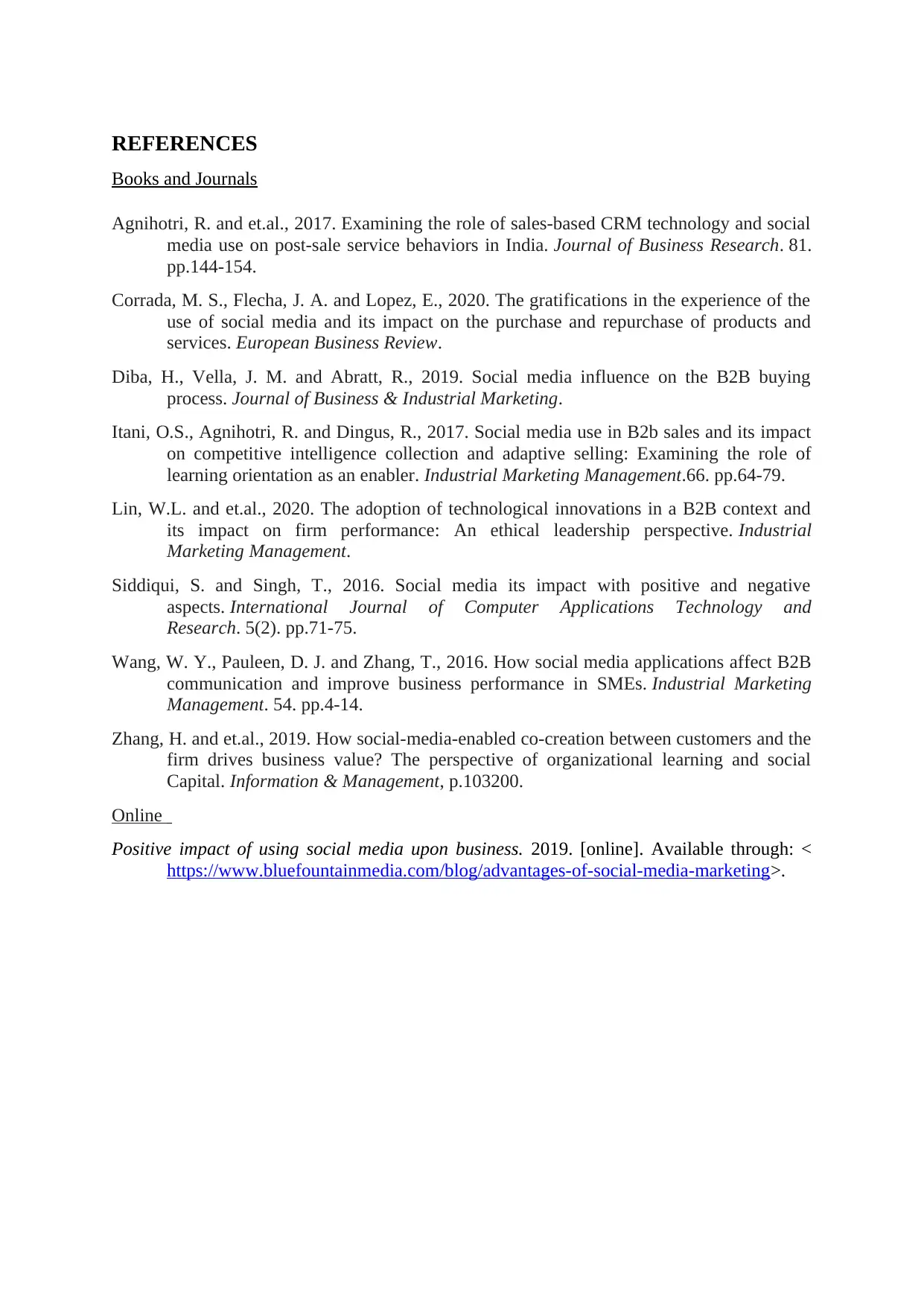
REFERENCES
Books and Journals
Agnihotri, R. and et.al., 2017. Examining the role of sales-based CRM technology and social
media use on post-sale service behaviors in India. Journal of Business Research. 81.
pp.144-154.
Corrada, M. S., Flecha, J. A. and Lopez, E., 2020. The gratifications in the experience of the
use of social media and its impact on the purchase and repurchase of products and
services. European Business Review.
Diba, H., Vella, J. M. and Abratt, R., 2019. Social media influence on the B2B buying
process. Journal of Business & Industrial Marketing.
Itani, O.S., Agnihotri, R. and Dingus, R., 2017. Social media use in B2b sales and its impact
on competitive intelligence collection and adaptive selling: Examining the role of
learning orientation as an enabler. Industrial Marketing Management.66. pp.64-79.
Lin, W.L. and et.al., 2020. The adoption of technological innovations in a B2B context and
its impact on firm performance: An ethical leadership perspective. Industrial
Marketing Management.
Siddiqui, S. and Singh, T., 2016. Social media its impact with positive and negative
aspects. International Journal of Computer Applications Technology and
Research. 5(2). pp.71-75.
Wang, W. Y., Pauleen, D. J. and Zhang, T., 2016. How social media applications affect B2B
communication and improve business performance in SMEs. Industrial Marketing
Management. 54. pp.4-14.
Zhang, H. and et.al., 2019. How social-media-enabled co-creation between customers and the
firm drives business value? The perspective of organizational learning and social
Capital. Information & Management, p.103200.
Online
Positive impact of using social media upon business. 2019. [online]. Available through: <
https://www.bluefountainmedia.com/blog/advantages-of-social-media-marketing>.
Books and Journals
Agnihotri, R. and et.al., 2017. Examining the role of sales-based CRM technology and social
media use on post-sale service behaviors in India. Journal of Business Research. 81.
pp.144-154.
Corrada, M. S., Flecha, J. A. and Lopez, E., 2020. The gratifications in the experience of the
use of social media and its impact on the purchase and repurchase of products and
services. European Business Review.
Diba, H., Vella, J. M. and Abratt, R., 2019. Social media influence on the B2B buying
process. Journal of Business & Industrial Marketing.
Itani, O.S., Agnihotri, R. and Dingus, R., 2017. Social media use in B2b sales and its impact
on competitive intelligence collection and adaptive selling: Examining the role of
learning orientation as an enabler. Industrial Marketing Management.66. pp.64-79.
Lin, W.L. and et.al., 2020. The adoption of technological innovations in a B2B context and
its impact on firm performance: An ethical leadership perspective. Industrial
Marketing Management.
Siddiqui, S. and Singh, T., 2016. Social media its impact with positive and negative
aspects. International Journal of Computer Applications Technology and
Research. 5(2). pp.71-75.
Wang, W. Y., Pauleen, D. J. and Zhang, T., 2016. How social media applications affect B2B
communication and improve business performance in SMEs. Industrial Marketing
Management. 54. pp.4-14.
Zhang, H. and et.al., 2019. How social-media-enabled co-creation between customers and the
firm drives business value? The perspective of organizational learning and social
Capital. Information & Management, p.103200.
Online
Positive impact of using social media upon business. 2019. [online]. Available through: <
https://www.bluefountainmedia.com/blog/advantages-of-social-media-marketing>.
⊘ This is a preview!⊘
Do you want full access?
Subscribe today to unlock all pages.

Trusted by 1+ million students worldwide
1 out of 16
Related Documents
Your All-in-One AI-Powered Toolkit for Academic Success.
+13062052269
info@desklib.com
Available 24*7 on WhatsApp / Email
![[object Object]](/_next/static/media/star-bottom.7253800d.svg)
Unlock your academic potential
Copyright © 2020–2025 A2Z Services. All Rights Reserved. Developed and managed by ZUCOL.





